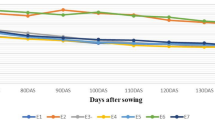Summary
Carbon isotope discrimination (Δ) is an important character regarding to water-stress tolerance in wheat. In this study, F2 backcross reciprocal monosomic crosses between varieties Falchetto (low Δ) and 18 monosomic lines of Oxley (high Δ) were used to identify chromosomal location of the gene (s) responsible for carbon isotope discrimination and therefore to detect allelic variation between the two wheat varieties. F2 reciprocal monosomic families were initially assessed for dry matter production. F2 families belonging to the chromosomes that indicated allelic variation for dry matter production were then assessed for Δ. The results revealed that reciprocal families belonging to chromosomes 1B, 7B, 1D and 5D indicated significant differences from which the family having chromosome 1D from Falchetto had the highest difference from its relevant reciprocal. Assessing the reciprocals of this chromosome for evapotranspiration efficiency (ETE) at the F3 disomic generation indicated that the observed variation for Δ was translated into differences for ETE. These results indicate that chromosome 1D of Falchetto is promising in reducing Δ and that the improvement of wheat varieties for ETE can be done by selection for Δ. When selecting for Δ, managing the experiment is easier and there is no need to monitor the water use during the growth cycle.
Similar content being viewed by others
References
Al Hakimi, A., P. Monneveux & E. Deleens, 1996. Selection response for carbon isotope discrimination in a Triticum polinicum × T. durum cross: Potential interest for improvement of water efficiency in durum wheat. Plant Breed 115: 317-324.
Araus, J.L., G.A. Slafer, M.P. Reynolds & C. Royo, 2002. Plant breeding and drought in C-3 cereals: What should we breed for? Ann Bot 89: 925–940.
Buerstmayr, H., M. Lemmens, G. Fedak & P. Ruckenbauer, 1999. Back-cross reciprocal monosomic analysis of Fusarium head blight resistance in wheat (Triticum aestivum L.). Theor Appl Genet 98: 76–85.
Condon, A.G., G.D. Farquhar & R.A. Richards, 1990. Genotype variation in carbon isotope discrimination and transpiration efficiency in wheat. Leaf gas exchange and whole plant studies. Aust J Plant Physiol 17: 9–22.
Ehdaie, B. & J.G. Waines, 1994. Genetic-analysis of carbon isotope discrimination and agronomic characters in a bread wheat cross. Theor Appl Genet 88: 1023–1028.
Ehdaie, B. & J.G. Waines, 1996. Dwarfing genes, water use efficiency and agronomic performance of spring wheat. Can J Plant Sci 76: 707–714.
Farquhar, G.D. & R.A. Richards, 1984. Isotopic composition of plant carbon correlates with water use efficiency of wheat genotypes. Aust J Plant Physiol 11: 539–552.
Griffiths, H., 1993. Carbon isotope discrimination. In: D.O. Hall, J.M.O. Scurlock, H.R. Bolhar-Nordenkampf, R.C. Leegood & S. Long (Eds.), Photosynthesis and Production in a Changing Environment, pp. 181–192. Chapman & Hall, London.
Law, C.N. & A.J. Worland, 1996. Inter-varietal chromosome substitution lines in wheat- revisited. Euphytica 89: 1–10.
Law, C.N., J.W. Snape & A.J. Worland, 1987. Aneuploidy in wheat and its uses in genetic analysis. In: F.G.H. Lupton (Ed.), Wheat Breeding: Its Scientific Basis, pp. 71–108. Chapman & Hall, New York.
Merah, O., E. Deleens & P. Monneveux, 1999. Grain yield, carbon isotope discrimination, mineral and silicon content in durum wheat under different precipitation regimes. Physiologia Plantarum 107: 387–394.
Mohammady-D, S., 2002. Inheritance of tolerance to water-stress in wheat (Triticum aestivum). Ph.D. Thesis. University of Newcastle upon Tyne. UK.
Quarrie, S.A., J. Stojanovic & S. Pekic, 1999. Improving drought resistance in small grain cereals: A case study, progress and prospects. Plant Growth Regulation 29: 1–21.
Rebetzke, G.J., A.G. Condon, R.A. Richards & G.D. Farquhar, 2002. Selection for reduced carbon isotope discrimination increases aerial biomass and grain yield of rainfed bread wheat. Crop Sci 42: 739–745.
Snape, J.W., B.B. Parker & M.D. Gale, 1983. Use of the backcross reciprocal monosomic method for evaluation chromosomal variation for quantitative characters. In: S. Sakamoto (Ed.), Proceedings of 6th International Wheat Genetics Symposium. Kyoto, pp. 367–373.
Steel, R.G.D. & J.H. Torrie, 1976. Introduction to Statistics. McGrow-Hill, New York.
Zadoks, J.C., T.T. Change & C.F. Knozak, 1974. A decimal code for growth stages of cereals. Weed Res 14: 415–421.
Author information
Authors and Affiliations
Corresponding author
Rights and permissions
About this article
Cite this article
Mohammady-D, S. Chromosome 1D as a possible location of a gene (s) controlling variation between wheat (Triticum aestivum L.) varieties for carbon isotope discrimination (Δ) under water-stress conditions. Euphytica 146, 143–148 (2005). https://doi.org/10.1007/s10681-005-6824-1
Received:
Accepted:
Issue Date:
DOI: https://doi.org/10.1007/s10681-005-6824-1




